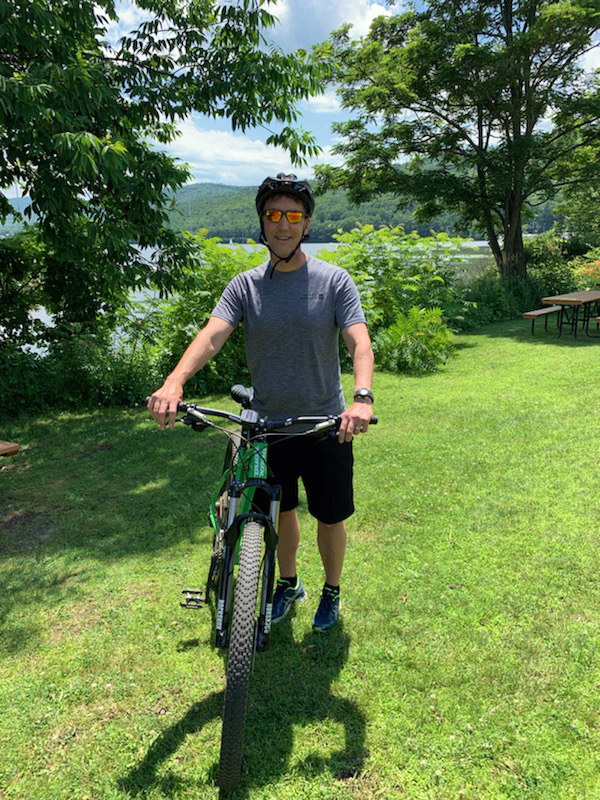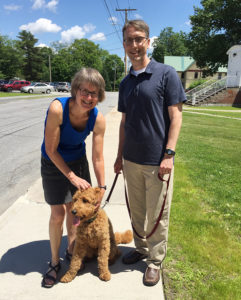

Dan and wife Jane walk their dog, Teddy, outside Gifford Medical Center a week after Dan’s hip replacement.
Earlier this month we sat down for a Q&A with Dan Bennett, our president and CEO, to learn about his recent hip replacement at Gifford. Diagnosed with arthritis at 41—he’s now 49—Dan had long lived with pain and audible “popping and clicking” in his right hip. An athlete, he tolerated the discomfort for years, one by one giving up favorite sports and other activities, from running 10Ks to playing baseball in a local league, before deciding to have joint replacement surgery this summer with orthopedic surgeon Dr. Alexander Orem.
Dan was back to work one week after his hip replacement, a cooler filled with ice to help reduce swelling tucked into a corner of his office, and was happy to share his experience here on the Gifford blog:
Why did you decide to have a hip replacement now?
DB: I started to have pain in that area. I had discomfort for a couple of years before I first talked to an orthopedist. I was a runner for 20-plus years. I had to stop running a decade ago; I did my last 10K two months before my doctor told me I couldn’t run anymore. Last fall I had to give up tennis. I had been playing baseball [with the Randolph Jays] but played a couple of games and it was too painful. I tried to start mountain biking with my son, but that was too painful. The pain was impacting my sleep the last six to eight months. Even walking the dog became difficult. All those factors, giving up all those things, led to my decision to have the hip replacement.
How did you prepare for surgery?
DB: I worked ahead of time to get my legs and core in as good a shape as possible before surgery.
How was recovery* immediately after surgery?
DB: I had surgery on a Monday morning. I was finished and moved to a patient room on Howell Pavilion [Gifford’s inpatient unit] by noon. I was able to get out of bed mid-afternoon, aided by crutches, and went home before noon on Tuesday. I took only two pain pills. I have been controlling pain by icing, and had a medicine regimen before, during and after surgery to keep the need for pain medications to a minimum.
How are you feeling now, a week after surgery?
DB: Well, I am able to be here, back to work two-thirds of the time. I have a big cooler of ice and need to elevate my leg to keep the swelling from getting too bad. I was told to expect three to six weeks of swelling. If I had a physically demanding job I probably wouldn’t be back at work.
How does physical therapy factor into your recovery?
DB: I met with Patrice Conard in PT [physical therapy] and Ann Mason in OT [occupational therapy] before I went home, and they reviewed exercises for me to do over the next few months. I also started outpatient PT with Rachel Westbrook at Kingwood Health Center. She asked me about my goals, about what I wanted to be able to get back to doing—realistically. I told her I want to be able to get back to playing golf by the end of summer, and ride a bike by the end of the season. I’d like to play baseball next year and get back on the tennis court (indoors) next winter. In the meantime, I want to walk my dog again.
I will be working with Rachel and Dr. Orem to make sure I am progressing at a healthy pace.
Did you find anything surprising about the experience, either the procedure or recovery?
DB: Dr. Orem, and other people as well, said that I wouldn’t believe the difference in the lack of pain after surgery. They were right. Dr. Orem does the anterior approach, which means less disturbance to the muscles and swifter recovery in the first few weeks. The pain in my knee and foot, which had deteriorated because of my hip—I had been out of alignment—also was gone.
And the fact that I was able to walk so quickly was surprising.
In terms of my hospital stay, I was surprised at how quiet and private it was on HP [Howell Pavilion], and by the room-service meals—real food! My care was excellent, from pre-op to ambulatory care to recovery to physical therapy. Everyone was wonderful, and also provided great communication to my wife, Jane, while I was still under anesthesia.
Basically, my experience confirmed what I already knew to be true of our team: The skill and care from our providers and staff is of the highest quality.
#

Photo of Dan biking courtesy of Jane Bennett.
Dan was back to walking his dog a week after surgery, and, while he isn’t mountain biking just yet, he was able to take a leisurely ride on a bike path four weeks after his hip replacement.
*NOTE: Each patient is different. Readiness improves results. Part of achieving readiness before surgery is making sure the patient, with their provider’s support, modifies behaviors and conditions affecting their health, such as smoking, a body mass index (BMI) over 40, and uncontrolled diabetes. Once a patient decides to have joint replacement surgery at Gifford, their provider identifies any issues, talks the patient through what to expect, and encourages a caregiver to be part of the conversation.
###
Orthopedics at Gifford
The Orthopedics team at Gifford works with patients at all stages of life, from infant to late geriatric, and is committed to treating patients holistically and personally, tailoring care for the individual. For more information, visit giffordhealthcare.org/service/orthopedics.

